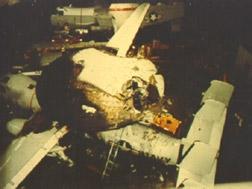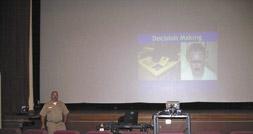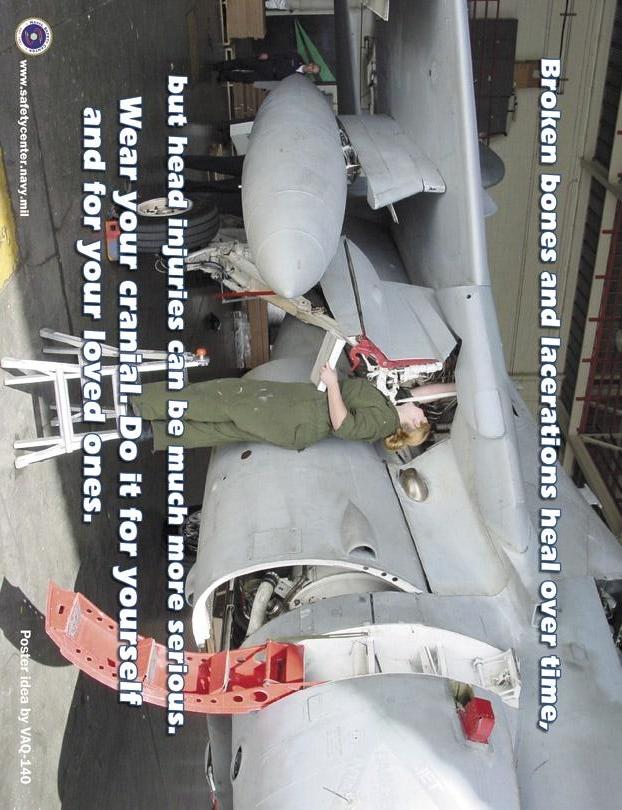
15 minute read
Crossfeed
from MECH Fall 2006
Maintenance Officer
LCdr. Bert Ortiz bert.ortiz@navy.mil
Advertisement
Editorial Coordinator
AMC(AW) Paul Hofstad
Airframes
Reaffirming Basic Hydraulic Rules
By AMC(AW) Paul Hofstad
In the last six months, we’ve noticed a bad trend in sampling procedures. In some cases, the problem is a misinterpretation of the NAVAIR 01- 1A-17, local MIMS, and type aircraft MRCs. When commands interpret too much, they lose the ability to maintain an effective aircraft hydraulic-control program.
NAVAIR 01-1A-17 states samples will be taken after extensive maintenance or crash/battle damage, when a metal-generating component failure has occurred, when erratic flight-control function or hydraulic-pressure drop is noted, when repeated or extensive system malfunction occurs, any time the system is subjected to excessive temperature, or in any other instance when contamination is suspected. Paragraph 5-7 states, “Hydraulicsystem fluid sampling shall be accomplished on a periodic basis in accordance with applicable MIM, MRC, and rework specifications.”
The last reference brings up a good point. If your command does samples on acceptance and transfer inspections only, then an aircraft may not get sampled for one, two, or even three years, depending on its rework schedule. In this case, wings should get involved and set a realistic schedule.
Another point to think about is logging and tracking samples. I have reviewed many trend logs in the last two years, and I’ve noticed inconsistencies in logging samples. If you make a mistake entering a sample, don’t “white it out.” Cross it out with one line, provide a small explanation like paul.hofstad@navy.mil “wrong system” or “wrong aircraft,” and then initial it. Also, make sure it’s accurate. The trend log should give anyone who looks at it a reasonable idea of the aircraft’s history. After all, that’s one purpose of the trend log. More importantly, the log ensures the hydraulic systems are in good order and safe for the aircrew to operate the aircraft.
Incredibly, I have seen cases where an aircraft has gone years without samples. When I researched NALCOMIS, I found that many components had been changed in that time, including flight-control actuators, wheel assemblies, reservoirs, and hydraulic pumps. One of the key problems with this lack of valid testing is that we are teaching our future leaders the wrong process. We need to show our young CDIs how to make the right call on when to take a hydraulic sample. This step is critical because we don’t want them to make a rushed decision just to make a launch or because of fear of reprisals. They need to make the right decision based on maintaining a fully functional hydraulic system.
I recently asked some airframers why they hadn’t taken samples when they changed a hydraulic pump. Their answer was shocking, “Oh, we were in Afghanistan on that one, Chief; we didn’t take a sample because we had jets to get back in the air.” We have to do a better job. It begs the question: Are we good or lucky? When we leave such a critical decision up to the interpretation of a manual, we better get it right. Chief Hofstad is a maintenance analyst at the Naval Safety Center.
Respirator
Who Owns the Respirator Program?
By AMC(AW) Paul Hofstad
I’ve discovered a trend that shows how important it is to take ownership of your programs, specifically the respiratory-protection program manager (RPPM). The CO designates a person in the command as RPPM, meaning that person has the command and respirator wearer’s full trust. At this point, the newly designated RPPM should assume full responsibility and ownership of the program. Is that easier said than done? Not really. One of the first actions should be to make sure all references are up to date. Two recent changes have occurred to RPPM instructions, yet 75 percent of the commands I’ve looked at were not aware of them.
In December 2005, OPNAVINST 5100.23F changed to the .23G. In May 01, 2006, CNAF 4790.2 had its first change. Volume 1, Chapter 10, Section 10.3.1 has three pages of changes affecting RPPM, hazmat and corrosion. In most cases, QA is aware of the changes, but the changes have not made it to the shops, or the CTPL is not verifyOil and the Lab Rats ADC(AW/SW) Gary Eldridge
Oil analysis is a critical part of aviation maintenance and a few tips will make sure the fleet uses the system correctly.
The Joint Oil Analysis Program (JOAP) was established as a combined effort to maintain a standard program that would consolidate and coordinate the service’s oil-analysis programs. The oil-analysis diagnostic programs allow us to make sure fluids are suitable for use in aeronautical and ing these changes have been made in the work center.
OPNAVINST 5100.23G, 1513(8) states the RPPM will do an annual audit of the program. This paragraph does not state that a QA, wing or even a Safety Center review will suffice. It specifically states that the RPPM will do this audit.
It’s at this point that ownership enters. Who knows the program better than the RPPM? Unfortunately, only a couple of commands I have looked at actually had done an RPPM audit. Their programs looked great and reflected pride.
Commands who take ownership have an outstanding program 100 percent of the time. They stay on top of their program, making upkeep easy. Those who don’t take ownership normally have a litany of discrepancies. For them, trying to fix the program and stay on top of it may seem futile, but it’s a job that must be done. Maintainer’s lives are at stake.
Chief Hofstad is a maintenance analyst at the
Oil Analysis
Naval Safety Center. non-aeronautical engines, transmissions, gearboxes, and other components.
The Navy Oil-Analysis Program (NOAP) defines the policies, procedures, and responsibilities for maintenance programs throughout the Navy. The NOAP is part of and operates in compliance with the JOAP. Oil Analysis laboratories are located at AIMDs and SIMAs.
The oil analysis operator-evaluator analyzes
used lubricants and hydraulic fluids, evaluates the condition of the fluid or the end equipment that it came from, and recommends maintenance actions to the equipment-operating activity.
This information sounds good, but I’ve noticed a few problems recently and put together a list, with the aid of William Zdrojewski (an oil-lab NATEC rep), to make sure your lab is in good shape. 1. PPE is critical. One type of glove is not always compatible for every chemical in an oil laboratory. Neoprene, nitrile, butyl rubber each have their use in our oil labs. Our labs use methanol, toluene, and potassium hydroxide. Some laboratories have nitric acid for cleaning generators or Aquatest 2010. Sodium hydroxide also is used. The oil lab should have a list available stating what PPE is necessary for each hazard present. 2. Fume hoods should be checked annually for flow rate, maximum sash height, and proper operation. Maximum sash height should be marked clearly. The on/off switch should be identified. No equipment, other than what you’re working on, should be in the fume hood that will hinder proper flow through the hood. An indicator, such as a vaneometer, should be used to indicate that hood is on, and a flow of air should exist up and out through an exhaust. Risks By AMC(AW) Paul Hofstad
Last year, I wrote an article titled, “Gas-Free Engineering, It’s Still There.” Its purpose was to answer a host of questions that the fleet often asks. I’ve collaborated with our AME and AD analysts to address more questions and phone calls received concerning confined-space entry. Please note, however, that we do not set policy on aviation maintenance. We do provide advice on those policies. NAVAIR, AMMT, and wings should be contacted when addressing questions concerning policy.
3. Propane tanks are used to do flashpoint testing. Tygon tubing (or other plastic or rubber tubing) should not be used to connect tanks to flash-point equipment. These lines should be stainless steel or copper tubing and must be “hard plumbed” in. Propane tanks should be of the type authorized, and they need to be hydrostatically tested at least once a year. A spark arrestor should be inserted in the line between the tank and the tester. 4. Waste containers should be marked to indicate what is in them. Should a fire occur in a space, firefighters need to know what they are dealing with in the compartment. 5. All chemicals and containers should be marked to indicate what is in them. 6. Good lighting is important and most oil laboratories are too dim. 7. An eyewash station should be nearby. 8. A safety shower should be nearby. 9. Flammable liquids should be stored in a flammable locker?
The key to a successful oil lab is to monitor and diagnose the condition of equipment or chemicals in the lab. Remember, think safety and always practice what you preach when doing any job that involves chemicals because it can affect your life.
Chief Eldridge is a maintenance analyst at the
AVGFE
Confined-Space Entry, New Name With Same
Naval Safety Center.
We have received several questions about the NAVAIR-01-1A-35: Aircraft Fuel Cells and Tanks. The main source of confusion is the definition of “hands/arms/tool-in” maintenance procedures, and the need for an entry authority (EA) to issue a gas-free certificate.
When an aircraft’s fuel cell is so small that a person can fit in only arms and hands, the initial lower explosive limit (LEL) checks only are required for a Class 5 Permit—see NAVAIR 01- 1A-35 WP 00400, pgs. 16 and 17, paragraphs 70 through 81 for more details. If a person’s head enters a cell, a gas-free certification still is required to be updated periodically.
A caveat to this requirement does exist: For hands-in/tool-in maintenance, the specific steps in NAVAIR 01-1A-35, paragraph 71 and subsequent sub-paragraphs must be accomplished. Specifically, the book says, “Safety procedures, including specifying the PPE, explosion-proof equipment, etc., shall be specified in written maintenance procedure for the TMS. Before maintenance begins, the level of fuel shall be lower than the area in which maintenance is being conducted. Disconnect electrical power and batteries. Do not perform By AMC(AW) Paul Hofstad
From April 01, 2006, to June 30, 2006, the Navy and Marine Corps had 25 Class-C mishaps that involved 28 aircraft. The damage total was $2,289,510. Twenty-four of the mishaps still are under investigation, leaving just one mishap to discuss.
The mishap in question is one we see each quarter: damage to an aircraft that occurred during an aircraft move—this one returning from high power. The facts may sound familiar, and it occurs when steps are missed while preparing to tow an aircraft. The mishap line leading petty officer (MLPO) directed the mishap tow-tractor driver (MTD) and mishap brake rider (MBR) to proceed to the highpower area with a power cart. When done with the turn, he instructed them to bring the mishap aircraft back from the high-power area and park it on the squadron line. The MLPO had been in the shop hot work. Do not perform concurrent maintenance. Post a fire watch and comply with all electrostaticdischarge requirements in accordance with procedures identified in the 35 manual.”
With publication changes also comes confusion, which now has occurred. If maintenance personnel lose focus of the hazards of working in an open fuel cell, they are a spark away from disaster. Our program managers must make sure their people adhere strictly to instructions and publications. They also must make sure the right documents are maintained, which will help mitigate the risks associated with open fuel cells.
If personnel don’t use good judgment and don’t follow safety procedures, the tiniest spark can result in catastrophic damages. Five personnel lost their lives in an explosion while doing fuel-cell maintenance on an E-2C. They did not do LEL checks, and a simple spark from an unauthorized maintenance light killed them in an instant. We need to protect our folks to prevent repeating this tragedy.
Chief Hofstad is a maintenance analyst at the Naval Safety Center. AMEC(AW/SW/NAC) Ellen Darby and ADC(AW) Gary Eldridge assisted with
Class C Mishap Summary
the article. for approximately two weeks before the incident. He asked the MTD and MBR if they had been to the high-power area in the past, and they said they had. Upon arrival at high-power spot No. 2, the MTD and MBR positioned the power cart slightly in front of the starboard engine, applied electrical power, and completed the high-power turn with the turn crew. Everyone helped to break down the aircraft, placing the chains on the tow tractor.
They then called maintenance to request a “follow-me truck.” The MTD and MBR discussed the hazards of towing the aircraft around the power cart, which still was in front of the starboard engine. They ultimately decided to position the tow bar to the left of the aircraft’s nose, allowing the aircraft to move around the power cart. The follow-me truck arrived about an hour after the initial request. Once clear of the power cart, the MTD made a right-hand turn to pull in behind the follow-me truck.
At this point, an aircraft was taxiing from the NADEP line and appeared to be on an intercepting course with the squadron’s aircraft, according to the MTD. The tow-tractor driver increased his turn to avoid what he felt was an impending collision. Focusing attention on avoiding the taxiing aircraft and pulling in behind the MFT, the MTD looked back and realized the MA had struck an object. He backed the aircraft off the obstruction and signaled to the MBR to hold brakes. The rest of the move went without incident.
I have only one question: Why didn’t anyone simply move the power cart out of the way? We By AMC(AW) Paul Hofstad
Already during FY06, there have been 102 ClassC mishaps that involved 111 aircraft. More importantly, six of those mishaps involved injury to personnel, resulting in 21 lost workdays. The following summary provides a breakdown of the top six causal factors for Class C mishaps around the fleet: 1. Fifteen of the mishaps involved aircraft under the positive control of aircrew, maintenance personnel or yellowshirts that were taxied, towed, or directed into other objects, such as aircraft or buildings. Equal blame can be shared because aircrew and maintenance personnel (squadron and yellowshirts) had instances when they lost focus on the aircraft or got in a hurry. 2. Ten of the mishaps resulted from things falling off aircraft, better known as TFOA. These items ranged from engine-bay doors to cowlings. In a couple of the mishaps, pieces hit and damaged the aircraft before falling to earth. 3. Support equipment is third on the list, damaging eight aircraft. The causes ranged from a piece of gear not being tied down to maintainers towing the gear into aircraft. 4. Foreign object damage (FOD) is tied for third. About 50 percent of the FOD incidents were from objects departing the aircraft and being sucked down the intake during takeoff or in flight. One of the FOD mishaps is worth mentioning can’t always predict what our Sailors are going to do, but we can teach them to expect the unexpected and to plan for contingencies. That approach doesn’t always solve the problem, but this case seems simple. Our people were too lazy to take care of the gear before it became a problem. The power-plants leading petty officer, who was on the scene, should have taken charge and provided basic functional leadership over the folks involved in the move. This incident cost us $89,797.
Chief Hofstad is a maintenance analyst
2006: Class C Summary in Review
assigned to the Naval Safety Center. because it directly involved maintenance personnel. A technician got too close to the intake and felt a tug on his head. The lenses from his goggles were sucked off his cranial and went straight down the intake—just a little too close for comfort. 5. In five mishaps, seven sub-components were jettisoned from aircraft, including three drop tanks and two canopies. Neither of these incidents happened in flight: One was during a pre-flight inspection and the other on post-flight inspection. 6. Four F-18 canopies were destroyed as a result of the exhaust from other aircraft. Advances in technology certainly have made the maintenance person’s job easier in the last 10 years or so, but it’s not without cost. As with anything new, we have to learn its characteristics and capabilities. This problem will take concerted effort to control. This list shows that we still have FOD, TFOA and SE issues. With the advances in technologies, we pay a hefty price when one of our assets is damaged. More than 50 of the Class C mishaps were in the group described, which is half of this year’s total. Most of these mishaps occurred because of direct maintenance errors, and the Navy and Marine Corps shelled out $6,445,376 in repair costs on these Class C mishaps alone. Maintainers are doing a good job, but we can do better. Commit to excellence.
Chief Hofstad is an Airframes Analyst and the Crossfeed Coordinator for the Naval Safety Center.
H otel Sierra Helping Sailors and Marines Help Themselves Sierra H otel Commander, Naval Safety Center would like to thank the following aviation commands for their recent participation in safety surveys, culture workshops, and maintenance malpractice (MMP)/khaki risk management (KRM) presentations for the months of May-August.




S afety S urveys VFA-94 VAQ-138 VFA-105 HSL-49 VFA-125 VAQ-142 VFA-81 HS-6 VFA-122 VP-40 VR-52 HSC-85 VFA-14 VAQ-141 VR-64 VMFA-121 VFA-41 VAQ-135 VR-1 HMMT-164 VQ-1 VR-61 VR-48 HMLA-267 VQ-2 VAQ-129 HSL-45 HMT-303 AIMD Lemoore AIMD Oceana AIMD Willow Grove
MMPs/KRMs NAS Lemoore MALS-12 VQ-1 VFA-27 NAS Fallon VAQ-135 HSL-51 NAS Atlanta VAQ-129 VFA-102 AMO School VQ-2 VAQ-136 VR-1 VAQ-141 VFA-192 CNATTU Oceana AIMD Whidbey Island HS-14 VP-40 VR-61 VAW-115 VAQ-130 VAW-124



57th Wing, Nellis AFB VR-52 HX-21 HSL-45 HSL-49 VRC-40 HMM-774
C ulture W orkshops
HMLA-775 HS-5 VAW-126 VFA-14 VFC-12 VT-31 NASA Air Ops Division HMH-769 VMGR-234 HMH-464 HMM-774 VMFA-115 HMH-466 VAW-120 VFA-32 VX-9 VT-35 H&HS Yuma VMA-211 HSC-28 VP-69

VMFA-112 HMH-461 VMFA-122 HSL-44 VFA-105 VFA-25 VFA-204
For more information or to get on the schedule, please contact: Safety Surveys: Capt Chris Foley, USMC at 757-444-3520 Ext. 7223, MMP/KRM: AEC Matthew Cooper at 757-444-3520 Ext. 7275, Culture Workshop: Cdr. John Morrison at 757-444-3520 Ext. 7213.











